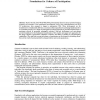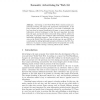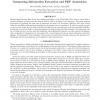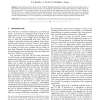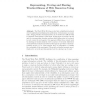116
Voted
JSCIC
2010
14 years 7 months ago
2010
A quantity known as the Kemeny constant, which is used to measure the expected number of links that a surfer on the World Wide Web, located on a random web page, needs to follow b...
105
click to vote
JOEUC
2010
14 years 7 months ago
2010
, The first decade of the World Wide Web predominantly enforced a clear separation between designers and consumers. New technological developments, such as the cyberinfrastructure ...
120
Voted
FIS
2009
14 years 10 months ago
2009
Abstract. Advertising on the World Wide Web is based around automatically matching web pages with appropriate advertisements, in the form of banner ads, interactive adverts, or tex...
133
Voted
DRR
2009
14 years 10 months ago
2009
Modern digital libraries offer all the hyperlinking possibilities of the World Wide Web: when a reader finds a citation of interest, in many cases she can now click on a link to b...
114
Voted
UM
2010
Springer
14 years 10 months ago
2010
Springer
Abstract. The World Wide Web has provided users with the opportunity to access from any computer the largest set of information ever existing. Researchers have analyzed how such us...
124
Voted
IDEAL
2010
Springer
14 years 10 months ago
2010
Springer
World Wide Web (WWW) is a vast source of information, the problem of information overload is more acute than ever. Due to noise in WWW, it is becoming hard to find usable informati...
102
Voted
TKDE
2010
14 years 11 months ago
2010
—Open distributed environments such as the World Wide Web facilitate information sharing but provide limited support to the protection of sensitive information and resources. Tru...
103
Voted
PUC
2010
14 years 11 months ago
2010
Microblogging is a ‘‘Mobile Web 2.0’’ service category that enables brief blog-like postings from mobile terminals and PCs to the World Wide Web. To shed light on microblog...
112
Voted
EKAW
2010
Springer
14 years 11 months ago
2010
Springer
The World Wide Web has evolved into a distributed network of web applications facilitating the publication of information on a large scale. Judging whether such information can be ...
122
click to vote
TON
1998
15 years 11 days ago
1998
—Clusters of identical intermediate servers are often created to improve availability and robustness in many domains. The use of proxy servers for the World Wide Web (WWW) and of...

